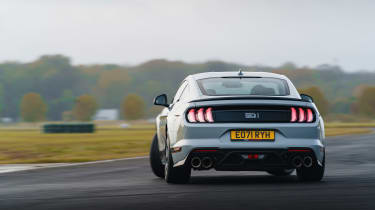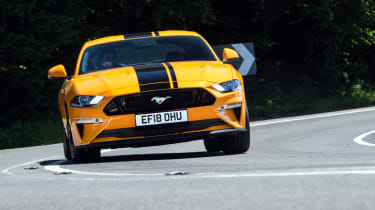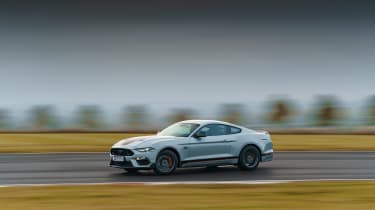Ford Mustang (S550, 2015 - 2023) – ride and handling
Unsurprisingly, it’s not as agile or sophisticated as a European rival, but there’s plenty of fun to be had, especially in Mach 1 form
The Mustang might not feel like such an exotic sight on UK roads since it arrived through official channels back in 2015, but to drive, it still feels anything but familiar. Drive it through a British village and it feels wide, long and totally out of scale with the traffic (and architecture around it).
It’s not quite as agricultural as it once was – Mustangs have been on independent rear suspension for a while now, but it’s still a very different experience in comparison to that of modern European coupes such as BMW’s 4-series. That’s not to say the experience is a bad one, of course. It’s just that the cumbersome steering and relative lack of mobility takes some getting used to.
Get past this initial intimidation and there’s a fluency to the car’s responses and a reasonably settled ride quality, especially on the impressive MagneRide dampers. It’s a fairly intuitive car to drive quickly, too, with a consistency and natural weight to the steering, plus a nice balance that manifests itself below the limits of grip. Unfortunately, there’s little actual feedback through the steering or chassis, which means there’s some second-guessing when approaching those limits, which come around quicker than you might imagine.
More reviews
In-depth reviews
Reviews
- Ford Mustang Dark Horse 2025 review – the last of a dying breed
- Ford Mustang GT 2024 review – old school in all the right ways
- Ford Mustang Mach-E GT 2023 review – it’s fast, but is it fun?
- Used Ford Mustang (Mk6, 2015 to date) review and buyer’s guide
- Ford Mustang Shelby GT500 UK review – how does Ford’s maddest muscle car handle Blighty?
- Ford Mustang Mach 1 2021 review – America’s BMW M4 gets track fit
- Ford Mustang Steve McQueen Bullitt Edition 2021 review – a 720bhp tribute act
> BMW M440i 2020 review – controversial coupe noses in on the Audi S5’s patch
Once at speed, the Mustang begins to lack ultimate body control – the dampers sometimes struggle to keep track of the car’s mass during quick direction changes, making it difficult to confidently ascertain where the weight is within the chassis. And weight there is, as the Mustang feels every bit of its 1760kg-plus figure. On expansive US roads the Mustang calls home, you’d probably not notice, but on the sort of broken B-roads found across the UK it results in the Ford feeling a little out of its depth – a little flustered and ponderous.
The steering doesn’t help, as Europe’s obsession with fitting a super-quick steering rack makes the Mustang’s feel ponderously slow by comparison – this is something that doesn’t usually grate on us, but when combined with a lazy chassis can feel obstructive when trying to take a road apart.
Recent experience with a Mustang equipped with a Koni Sport suspension set-up reveals only a little adjustment is needed to tease out the car's potential, though. With more body control and a lower ride height the ’Stang is at once a little more planted and a little more exploitable, without destroying the decent ride quality.
The Mustang’s brakes are strong, but their response isn’t perfect. Bite is almost instant and the pedal travel is quite short, making smooth, progressive braking more difficult than it should be. Wide spacing between brake and throttle pedals, and that grabby initial bite, also makes heel-and-toe downchanges difficult. Incidentally, it’s a problem not nearly as bad in the left-hand-drive car we drove most recently.
Despite these issues, the Mustang is still a lot of fun. Drive it below its limits and stick to smoother tarmac and it becomes much easier to appreciate the car’s good balance and progressive responses.
This is where the Mach 1 comes in, as it features a raft of chassis upgrades derived from the Shelby GT350 that significantly improve the car’s responses up to and beyond the limit. Both front and rear subframes are new, with stiffer anti-roll bars and stiffer springs and dampers at all corners. The MagneRide dampers (standard fit on Mach 1s) are also recalibrated to suit, and give the whole car a much more controlled ride quality on rougher British roads. It’s a little firmer on the road, yes, but it’s also significantly more tied down, and in combination with a quicker and more direct steering rack seems to shrink the Mach 1 on the road. It still feels like a Mustang, but a smaller, sharper and more responsive one – exactly the sort of thing we were asking for, and are so glad we got.
The Shelby GT500 takes things even further, and with staggering results, as the extra capability within the chassis, extra rubber on the road and extra power and response from the drivetrain make it not just quicker, but far more engaging at the same time. Rather than feeling like an over-engined muscle car – it does have 760bhp – the GT500’s real talent lies in how it makes all that power and performance feel so approachable.





